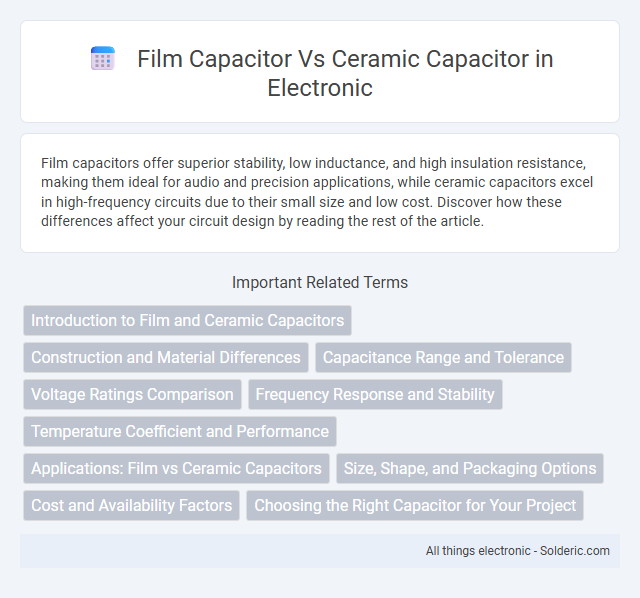Film capacitors offer superior stability, low inductance, and high insulation resistance, making them ideal for audio and precision applications, while ceramic capacitors excel in high-frequency circuits due to their small size and low cost. Discover how these differences affect your circuit design by reading the rest of the article.
Comparison Table
| Feature | Film Capacitor | Ceramic Capacitor |
|---|---|---|
| Dielectric Material | Plastic film (polyester, polypropylene) | Ceramic (titanate, zirconate) |
| Capacitance Range | 1 pF to several uF | 1 pF to 100 uF |
| Voltage Rating | Up to 1 kV or more | Typically up to 500 V |
| Tolerance | +-1% to +-5% | +-5% to +-20% |
| Temperature Stability | High stability, low drift | Moderate to low stability |
| Equivalent Series Resistance (ESR) | Low ESR | Moderate ESR |
| Applications | Precision filtering, timing circuits, audio | General-purpose, decoupling, bypass |
| Physical Size | Generally larger | Compact, small size |
| Cost | Higher cost | Lower cost |
Introduction to Film and Ceramic Capacitors
Film capacitors use a thin plastic film as the dielectric, offering low dielectric losses, high insulation resistance, and excellent stability over time and temperature changes. Ceramic capacitors employ a ceramic material as the dielectric, providing high capacitance in small sizes and superior high-frequency performance but with increased susceptibility to temperature and voltage variations. Your choice between film and ceramic capacitors depends on the specific application requirements, including size constraints, frequency response, and environmental stability.
Construction and Material Differences
Film capacitors consist of a thin plastic film dielectric, typically polyester or polypropylene, sandwiched between metal foil electrodes, providing stable capacitance and low dielectric losses. Ceramic capacitors use a ceramic dielectric material, such as titanium dioxide or barium titanate, layered between metal electrodes, resulting in high capacitance per volume but increased temperature sensitivity. Your choice depends on whether you need precise, stable performance (film capacitors) or compact, high-capacitance solutions (ceramic capacitors).
Capacitance Range and Tolerance
Film capacitors typically offer capacitance values ranging from a few picofarads to several microfarads with tight tolerance levels often as low as +-1% to +-5%, making them ideal for precision applications. Ceramic capacitors cover a broader capacitance spectrum, from picofarads up to tens of microfarads, but their tolerance varies widely, generally between +-5% and +-20%, depending on the dielectric class. The superior tolerance stability and minimal variation over temperature and voltage conditions make film capacitors preferable for high-accuracy filtering and timing circuits.
Voltage Ratings Comparison
Film capacitors typically offer higher voltage ratings, often exceeding 1,000 volts, making them suitable for applications requiring stable performance under high voltage stress. Ceramic capacitors generally have lower voltage ratings, usually up to a few hundred volts, but excel in high-frequency and compact designs. Your choice depends on the voltage demands and stability requirements of your specific electronic circuit.
Frequency Response and Stability
Film capacitors offer superior frequency response and excellent stability across a wide range of frequencies, making them ideal for high-precision audio and RF applications. Ceramic capacitors deliver high-frequency performance with low equivalent series resistance (ESR) but may exhibit capacitance shifts and reduced stability under varying temperature and voltage conditions. Selecting your capacitor depends on balancing the need for stable, consistent capacitance (favoring film) versus compact size and low ESL for high-frequency circuits (favoring ceramic).
Temperature Coefficient and Performance
Film capacitors exhibit a low temperature coefficient, typically around +-100 ppm/degC, ensuring stable capacitance and superior performance across wide temperature ranges, which makes them ideal for precision and high-frequency applications. Ceramic capacitors, especially Class 2 and Class 3 types, have higher temperature coefficients (up to +-3300 ppm/degC), leading to capacitance variations that can affect circuit stability and performance in sensitive electronic designs. The inherent stability and low dissipation factor of film capacitors contribute to enhanced reliability compared to ceramic capacitors under thermal stress conditions.
Applications: Film vs Ceramic Capacitors
Film capacitors excel in applications requiring high stability, low loss, and superior insulation, making them ideal for audio equipment, power supplies, and precision timing circuits. Ceramic capacitors are preferred in high-frequency and general-purpose applications due to their low cost, small size, and high volumetric efficiency, commonly found in decoupling, filtering, and RF circuits. Your choice between film and ceramic capacitors will depend on the specific performance requirements and environmental conditions of your electronic design.
Size, Shape, and Packaging Options
Film capacitors typically feature larger sizes and rectangular or square shapes, housed in robust, often molded plastic or metal cases suitable for high-voltage applications. Ceramic capacitors are usually smaller, available in a variety of compact, disc, or multilayer chip forms, ideal for surface-mount technology (SMT) packaging on printed circuit boards. Packaging options for film capacitors include radial and axial leaded configurations, while ceramic capacitors predominantly come in standardized SMD packages such as 0805, 1206, and 1812.
Cost and Availability Factors
Film capacitors generally have higher costs due to their complex manufacturing process and materials like polyester or polypropylene, but they offer better performance in high-frequency and high-voltage applications. Ceramic capacitors are more affordable and widely available, making them the preferred choice for mass production in consumer electronics. Your decision between the two should consider whether budget constraints or performance requirements take priority.
Choosing the Right Capacitor for Your Project
Film capacitors offer excellent stability, low equivalent series resistance (ESR), and high insulation resistance, making them ideal for audio circuits, precision timing, and filtering applications requiring long-term reliability. Ceramic capacitors provide compact size, high capacitance per volume, and low cost, suited for decoupling, bypassing, and high-frequency applications where space and budget constraints are critical. Selecting the right capacitor depends on factors like capacitance stability, voltage rating, frequency response, and environmental conditions to ensure optimal performance for your specific electronic project.
Film capacitor vs ceramic capacitor Infographic

 solderic.com
solderic.com